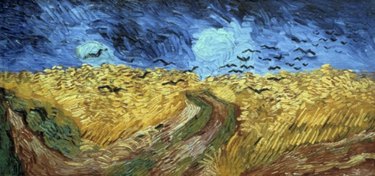Things You'll Need
Canvas (optional)
Heavy-grade drawing paper (optional)
Fine-grit sandpaper
Tack cloth
Water-based varnish
Standard HB pencil
Eraser
Acrylic Paint
Fine-tipped paintbrush

Post-Impressionistic artwork can add a bright and striking element to any room. This technique focuses on bold colors and exaggerated shapes while maintaining some of the same style as Impressionism. Creating your own post impressionistic piece of art can be more cost effective than purchasing one and shows off your creative side. Drawing and painting in the Post-Impressionism style can be achieved if attention to specific techniques is paid. Some basic steps and knowledge can help create a piece of artwork to be proud of.
Step 1
Select the subject matter to be drawn. Collect photos from your own collection or find pictures on the Internet to reference when drawing. Post-Impressionism generally focuses on real-life subject matter. A landscape or group of people engaging in an activity are possibilities when selecting a subject to draw.
Video of the Day
Step 2
Draw the desired picture on the canvas or heavy-grade drawing paper. Use a standard HB pencil to draw the background and objects in the foreground onto the surface. Post-Impressionism often emphasizes the geometric shapes of the objects in the picture. Start with all the basic shapes of each subject. For example, when drawing a person, create a circle for the head, rectangle for the body and long ovals for the arms and legs. Soften out rigid lines and connecting marks with an eraser after all the items have been drawn. This will make the objects more realistic while maintaining the integrity of the shapes.
Step 3
Paint the picture using an acrylic paint. Base-coat all the objects with their corresponding basic color. Use vivid colors and a heavy paint application to capture the look of post-impressionism. Choose an imaginary light source for the painting. Add highlights where the light source would naturally shine. Paint shadows on the opposite side of the highlights. Consider using unnatural colors to paint the subjects as this is a common technique in post impressionism.
Step 4
Add details to the painting. Post-Impressionistic paintings are generally soft and undefined. Paint details sparingly using a small, fine-tipped paintbrush and a light hand. Create a bright, dramatic look by exaggerating your brush strokes. Allow the paint to dry according to manufacturer's directions, printed on the back of the paint bottle.
Tip
If using a canvas, sand it lightly using a fine-grit sandpaper. Remove sanding debris with a tack cloth. . Apply two coats of water-based varnish.
Warning
Always paint in a well-ventilated area.
Video of the Day